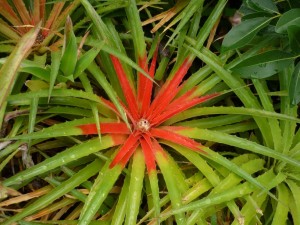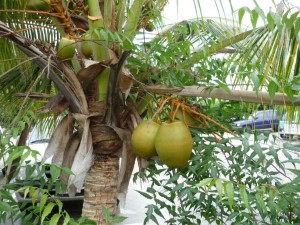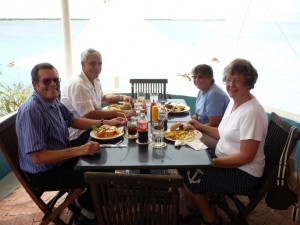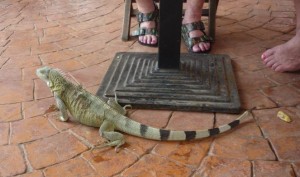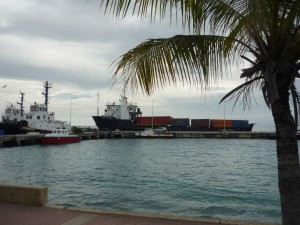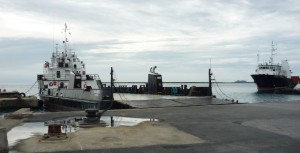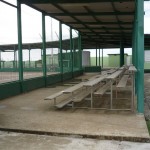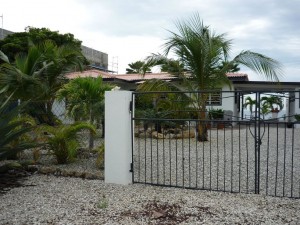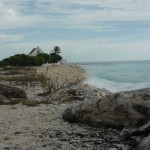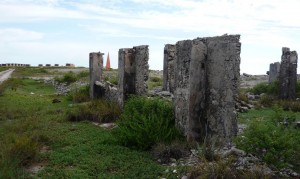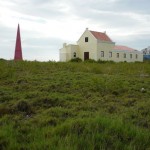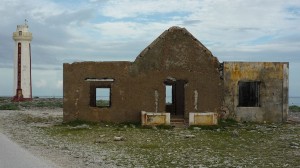This morning the two cruise ships, Sea Princess and Noordam, both arrived just before 8 am.
After devotions, I reprogrammed the thermostat that will be used for the 6 ton unit at the site, then documented these new settings. Also sent an email to Joe Barker with attachments of both the installation and operation guides for this thermostat.
I then headed to the transmitter site via town, this being the shortest and fastest way. Tourists were all over the place. Guess that’s what happens when almost 5,000 people stop in a town about 5 blocks long!
At the site, I noticed the water on the property was a couple of inches higher from the rains over the past few days. It is the highest that it has been since we got here. For additional photos visit TWR Bonaire on Facebook or, if much later than when this was written, try clicking here.
With the programmable thermostat all prepared for installation, this project was quickly completed. Had to remove the old thermostat, drill and tap new holes in the box cover to which it is attached, and reconnect the wires. The air conditioner was then switched on. Not sure that it is functioning up to par. Cool air is coming out of the vents, but it seems to take an hour for the temperature to drop a couple of degrees.
When I headed out the door to pick up Virginia for lunch, the rain was pouring down with a blustery south wind. Driving through town, there were lots of drenched tourists making their way back to the ships. Only noticed one that seemed to be enjoying the situation and that person was wearing a swimsuit and flip-flops.
While picking Virginia up for lunch, I also gathered a few small parts that were needed for the site. [I suspect, most of these items are also at the site, but I already knew their location in the studio’s tech lab.] Originally, Virgina was planning to pick up lunch from the vendor who prepares Bonairean food for the ships, but, because of the heavy rain, we ordered sweet-and-sour chicken from China Nobo instead.
Brrr — it was cold as we headed to the site. Only 80 degrees and still raining hard. I turned the defroster on to clear the condensation off the inside of the windows. Since there is no heater on the car, only an air conditioner, Virginia had a towel wrapped over her to keep warm. One doesn’t think they would feel cold at 80 degrees. The posted weather says partly cloudy, but the clouds are staying put for awhile.
The water at the site was about an inch deeper than this morning. Shortly after getting there, Gaby Felix (Amado’s younger brother) came from Cargil, the salt company, to inform us that he was going to start the pump to lower the water in the perimeter ditch around their salt pan bordering our property. Hopefully, this should help lower the water level on TWR property.
My first afternoon project was to connect the front door switch and remove the motion sensor for that area. Because of the preparation yesterday, this only took a few minutes.
I then moved the motion sensor into a more strategic location. This required running two pairs of wires — one pair for power and one pair for the sensor switch. When asked for a masonry drill for mounting the sensor, Benny said to use a regular drill. I was amazed that it was still pretty sharp after drilling two holes through plaster into block. After connecting power to the sensor and wiring the sensor switch in series with the other sensors, it was ready to test. It functioned amazingly well, even triggering with motion outside a couple of door openings into that area. I don’t think it could have been installed in any better place.
Next, I began to search out a way to control the tower lights remotely. The tower lights are feed from a circuit breaker panel, which goes to an control box with a contactor inside. The contactor is closed using a photo cell mounted outside the building, or by a manual switch on the side of the control box to override the photo cell. From the contactor, the power goes to a second circuit breaker box that has four separate breakers — one for each tower.
I noticed that there were two small control cables coming into this area. One was traced to extra contacts on the contactor. This provides a switched signal to the Gentner for indicating that the lights are on. The second control cable goes to a circuit, with three current transformers attached, that provides an metering signal to the Gentner of the amperes currently used by the lights. This measurement can be used to determine if there a light bulbs that are no longer functioning.
I need to ask if the switched contact is really necessary, since the metering signal will be zero, if the lights are not on. If not needed, this pair of wires can be used to provide for the remote override of the photocell. If needed, I could run another cable, but this would take extra time.
I mounted a relay socket in the second breaker panel, next to the current sensing circuit, instead of in the control box, which lacks room for it. Tomorrow, I will try to wire it up.
With the transmitter successfully starting up for the evening, we decided to head for home. It was still raining some and the wind was now out of the north. The water was another inch or so higher, as we drove through it on the road out. Hopefully the Cargill pump will begin to make a difference soon.
Nearing town, we noticed that the Noordam ship was just leaving for Curacao. We also noticed the big engines were puffing smoke on the Sea Princes. Virginia decided soup would be good for supper on such a ‘cold’ evening, so we stopped at Warehouse Bonaire Supermarket. In the few minutes that it took to purchase the soup and head for home, the Sea Princess was a half mile or so from shore, also headed for Curacao.
Tomorrow will be a part day for working. The staff is planning a farewell breakfast first thing, then the Pelikaan School is having an open house in the afternoon. All TWR staff has been invited to that. Pelikaan School purchased TWR’s former activity building across the street from the studio/office. It has continued to grow, and they also used part of the office wing for school while expanding their building. The building is now completed, so they are having an open house.
Click here on Pelikaan School and see if you can find Rich West in the first photo.
48 hours from now, we should be flying between Atlanta and Chicago on our way home. Right now it is supposedly 79F here, but it feels cooler than that.



